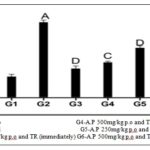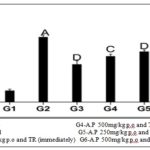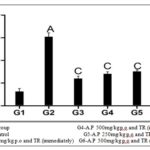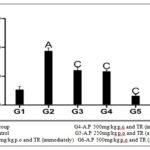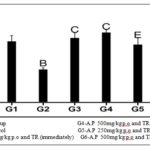ANTIHYPERLIPIDEMIC ACTIVITY OF ETHANOLIC EXTRACT OF AMORPHOPHALLUS PAEONIIFOLIUS TUBER IN TRITON WR 1339 INDUCED HYPERLIPIDEMIC RATS
HTML Full TextANTIHYPERLIPIDEMIC ACTIVITY OF ETHANOLIC EXTRACT OF AMORPHOPHALLUS PAEONIIFOLIUS TUBER IN TRITON WR 1339 INDUCED HYPERLIPIDEMIC RATS
Arti Gautam *, Pritt Verma, Shravan Kumar Paswan, Ila Shukla and Ch. V. Rao
Pharmacognosy and Ethnopharmacology Division, National Botanical Research Institute (CSIR), Lucknow - 226001, Uttar Pradesh, India.
ABSTRACT: Hyperlipidemia is the most prominent risk factor in coronary heart disease. The present study was designed to investigate the anti-hyperlipidemic activity of Amorphophallus paeoniifolius Tuber in Triton WR-1339 induced hyperlipidemic rats. Amorphophallus paeoniifolius extract was administered at a different dose of 250mg/kg, 500mg/kg (p.o) daily for 7 days to hyperlipidemic rats. Gemfibrozil is used as a reference standard. The statistical analysis was performed by using one way ANOVA followed by the Dunnet’s multiple comparison tests. This is to highlight the presence of the different secondary metabolites, extract by solvents (ethanol) and analyze the content of total phenols from the tuber by the visible UV spectrophotometry method. The results obtained indicate that the tuber of Amorphophallus paeoniifolius contains high concentrations of total phenols (respectively 79, 35 mg GAE/gDM). These polyphenols possess a strong anti-hyperlipidemic activity. Amorphophallus paeoniifolius showed a significant decrease in the levels of serum cholesterol, triglycerides, LDL (low-density lipoprotein), VLDL (very low-density lipoprotein) and the significant increase in the level of serum HDL (high-density lipoprotein) at the dose of 500mg/kg (p.o) against Triton induced hyperlipidemic rats. The objective of our work, frame a valorization of vegetable substances namely Amorphophallus paeoniifolius in the north Indian region. Therefore it effectively suppressed the Triton WR 1339 induced hyperlipidemia in rats, suggesting the potential protective role in Coronary heart disease (C.H.D).
| Keywords: |
Amorphophallus paeoniifolius, Hyperlipidemia, Triton WR-1339, Total cholesterol, Triglyceride
INTRODUCTION: Hyperlipidemia is one of the most prominent risk factors contributing to the prevalence of coronary heart diseases (C.H.D) 1. Coronary heart disease (C.H.D), stroke, atherosclerosis, and hyperlipidemia are the primary reason for death 2. Hyperlipidemia is characterized by elevated serum (T.C) total cholesterol, low-density lipoprotein, very low-density lipoprotein and decreased high-density lipoprotein (H.D.L) levels.
Hyperlipidemia associated lipid disorders are considered to cause atherosclerotic cardiovascular disease (C.V.D) 3. Among these hyperchole-sterolemia and hypertriglyceridemia are closely related to ischemic heart disease (I.H.D) 4.
The main objective of treatment in patients with hyperlipidemia is to decrease the risk of developing ischemic heart disease or the occurrence of further cardiovascular diseases like atherosclerosis or cerebrovascular disease 5. Now a day’s available drugs have been associated with a number of side effects 6. Amorphophallus paeoniifolius is also known as elephant foot yam and a crop of South East Asian origin. In India, it’s also known as "Suran" or "Jimmikand". It is widely distributed in wild form in Indonesia country, Malaysia, and other South East Asian countries of the world. This tuber is consumed by many of the people as a food and widely used in different type of Ayurvedic preparations 7. They are traditionally used in the tumor, arthralgia, inflammation, haemorrhage, hemorrhoids, vomiting, asthma, cough, bronchitis, anorexia, colic, dyspepsia, flatulence, constipation, hepatopathy, splenopathy, amenorrhea, dysmenorrhoea, seminal weakness, fatigue, several anemia and general debility 8. The tuber of A.P is reported to have CNS depressant 9, cytotoxic activity 10 and antiprotease activity 11.
By our best knowledge, the pharmacological properties A.P have not been studied extensively so far. Therefore, the aim of our current study was to determine the detailed in-vivo anti-hyperlipidemic activity of the ethanolic extract of tuber of (A.P) in healthy rats.
MATERIALS AND METHODS:
The Collection, of Plant Material: The fresh tuber of Amorphophallus paeoniifolius was collected from local market of Lucknow, India, In between month July-September. The tuber of Amorphophallus paeoniifolius authenticated from NBRI (National Botanical Research Institute) CSIR Lucknow.
Phyto-Chemical Screening: The chemical screening is a technique used to determine the chemical groups contained in a plant body by physicochemical reactions. Preliminary tests to determine the major chemical groups have been performed according to 12-13.
Preparation of Ethanol Crude Extract: The tuber of the plant was dried in the shade and prepared to a fine powder by using a laboratory mill. The powdered drug (approx. 200 gm) were then packed in the Soxhlet apparatus this powder was used for the preparation of ethanolic extract The powdered drug (approx. 200 gm.) were then packed in the Soxhlet apparatus and was extracted successively with ethanol (40-60) (Merck, India) and distilled water. After completion of the total, the extracted powder was discarded, and the ethanolic extract obtained was further processed. The excess solvent in the extracts was removed by the distillation process and the concentrated extracts so obtained were further dried at a temperature not exceeding 400 ºC in a water bath. The extracts were then collected kept in Petridis and stored in desiccators at room temperature. The yield values and other physical parameter were observed.
Determination of Total Polyphenols: The total polyphenol content of the extracts was determined by the Folin Ciocalteu method 14. A quantity of 200 ml of the extract was mixed with 1ml of freshly prepared reagent Folin-Ciocalteu reagent (10 times diluted) and 0.8 ml of sodium carbonate 7.5% (Na2CO3). The whole is incubated at room temperature for 30 min and the reading is taken against a blank using a spectrophotometer at 765nm. The results are expressed in milligrams gallic acid equivalent per g dry plant material.
Reagents: Triton WR-1339, Gemfibrozil was obtained from National Botanical Research Institute (N.B.R.I), CSIR Pharmacognosy and Ethnopharmacology division Lucknow. All other chemicals were of analytical grade and obtained locally.
Pharmacological Evaluation:
Experimental Animals: Wistar albino male rats weighing 200-250g were obtained from the animal house Pharmacognosy and Ethnopharmacology Division, N.B.R.I (National Botanical Research Institute), Lucknow, 226001, India. The animals were grouped and procure in polypropylene cages (38 × 23 × 10 cm) with not more than five animals each cage and maintained under standard laboratory parameter. They were allowed access to a standard dry pellet diet and water ad libitum. I.A.E.C approved the experimental procedure (Institutional Animal Ethical Committee) constituted under CPCSEA (committee for the purpose and co-supervision on the experimental animal) (Reg. No.173/GO/Re/13/CPCSEA).
Acute Oral Toxicity Studies: The adult Swiss albino mice of both sexes selected for acute toxicity study. Before the actual LD50 determination, a pilot study was made on a small group of mice (2 in numbers) mainly to select the dose range for the subsequent study the ethanolic extract of Amorphophallus paeoniifolius were taken at a various dose level in 1% carboxymethyl cellulose administered (10 ml/kg) orally. For the actual LD50 determination, the extract of Amorphophallus paeoniifolius was administered once orally at various dose levels.
To the group of 10 mice of both sexes about equal in number which has been fasting overnight (about 18 h). The control animal received 1% carboxymethyl cellulose in distilled water (10 ml/kg) orally.
The animals were observed continuously for 2 h and then occasionally for further 4 h and finally, overnight mortality recorded. The behavior of the animals and any other toxic symptoms also observed for 72 h. And the animals were kept under observation up to 14 days.
Antihyperlipidemic Studies:
Induction of Hyperlipidemia (Triton Induced Hyperlipidemia): Forty-two male Wistar rats weighing 190 to 230 gm were randomly divided into 7 groups of 6 each and kept in their cages for 5 days prior dosing to allow for familiarization to the laboratory conditions. The animals were starved for 18hr and then injected i.p. with 10% aqueous solution of TR at 400mg /kg body weight. Food was withdrawn 10 h before the blood sampling.
The test drugs employed (or) the solvent for control was administered simultaneously with TR injection. Serum analyzed made on 24th and 48th h after TR injection. The drug was administered in a constant volume of 1ml/100gm body weight. The control group animals received the vehicle in the same volume orally.
Group 1: Administered vehicle and served as normal control.
Group 2: Administered Triton WR 1339 (TR) and served as TR control.
Group 3: Administered Gemfibrozil (250 mg/kg), p.o, immediately after (TR) 400 mg/kg, i.p injection.
Group 4: Administered A.P. (500mg/kg), p.o., immediately after (TR) 400 mg/kg, i.p. injection.
Group 5: Administered A.P. (500mg/kg), p.o., after 22 h of TR 400 mg/kg, i.p injection.
Group 6: Administered Gemfibrozil (250 mg/kg), p.o., after 22 h of (TR) 400mg/kg, i.p injection.
Collection of Blood: On the 8th-day procedure, blood was collected by retro-orbital sinus puncture 15, under mild ether anesthesia. The collected samples were centrifuged for 10 min. Then serum samples were collected and used for various biochemical experiments. The animals were then sacrificed and the liver collected 16.
Liver Lipid Extraction: The liver was homogenized in cold 0.15M KCl and extracted with CHCl3CH3OH (2% v/v). This lipid extract was used for the estimation of lipid parameters 17.
Biochemical Analysis: The serum and liver extract were assayed for total cholesterol estimation was done by using the specimen cholesterol diagnostic kit, triglycerides estimation was done by using the specimen TG diagnostic kit, high-density lipoprotein (HDL), low-density lipoprotein (LDL) 12, very low-density lipoprotein (VLDL) using standard protocol methods 18.
Statistical Analysis: The results were expressed as mean + S.E.M. Statistical analysis was carried out by using ANOVA followed by Dunnet’s multiple comparison tests using graph pad PRISM software version. P values<0.01 were considered statistically significant.
RESULTS: Phyto-chemical screening of Amorphophallus paeoniifolius tuber Table 1:
TABLE 1: THE RESULTS OF THE CHEMICAL SCREENING
| Secondary metabolite | Ethanolic extract |
| Flavonoid | + + + |
| Glycoside | ++ |
| Tannin | +++ |
| Phenolic content | +++ |
| Protein and amino acid | + + - |
| Sterol and terpenoid | +++ |
| Carbohydrate | + + - |
| Fats and fixed oil | - + + |
Determination of Total Phenols Table 2: The determination of the content in total phenols in the ethanolic Amorphophallus paeoniifolius extract is made by using the colorimetric method of Folin-Ciocalteux. The results show that ethanolic extracts of A.P have a high content of total phenols (79, 35 mg GAE/gDM).
TABLE 2: TOTAL PHENOLIC CONTENT
| Extract | Yield | Total Phenolic Content |
| Ethanolic extract | 22% | 79,35 mg GAE/gDM |
Acute Toxicity Study Table 3: The 50% EtOH extract of Amorphophallus paeoniifolius shown 50% mortality at a dose level of 2000 mg/kg body weight orally.
TABLE 3: ACUTE ORAL TOXICITY STUDY
| S. no. | Groups | Dose kg/b.w | Signs of toxicity | Onset of toxicity | Duration of Toxicity |
| 1 | EEAP | 2000mg | No signs of toxicity | Nil | 14 days |
| 2 | EEAP | 2000mg | No signs of toxicity | Nil | 14 days |
| 3 | EEAP | 2000mg | No signs of toxicity | Nil | 14 days |
| 4 | EEAP | 2000mg | No signs of toxicity | Nil | 14 days |
| 5 | EEAP | 2000mg | No signs of toxicity | Nil | 14 days |
| 6 | EEAP | 2000mg | No signs of toxicity | Nil | 14 days |
Anti-Hyperlipidemic Activity:
Effect of Amorphophallus paeoniifolius on Total Cholesterol Levels Fig. 1: Rats treated with TR (400 mg/kg, i.p., once) had serum TC (Total cholesterol) level of (227 ± 6.69 mg/dl) when measured at 36th h. This was significantly higher (P<0.001) when compared to serum TC (Total cholesterol) levels in normal control rats (63.4 ± 7.06 mg/dl). TR rats treated with Gemfibrozil (250 mg/kg, p.o., once daily) had serum TC level of 150.2 ± 6.13 mg/dl when measured at 36th h.
This was significantly lower (P<0.001) when compared to the serum TC levels in TR control rats (227 ± 6.69 mg/dl). TR rats treated with E.E (ethanolic extract) (500 mg/kg, p.o, once daily) had serum TC level of 110 ± 6.92 mg/dl when measured at 36th h. These values were significantly lower (P<0.001) when compared to the serum TC level in TR control rats (227 ± 6.69 mg/dl).
Effect of Amorphophallus paeoniifolius on Triglyceride Levels Fig. 2: Rats treated with TR (400 mg/kg, i.p., once) had serum TG level of (373.6 ± 11.97 mg/dl) when measured at 36th h. This was significantly higher (P<0.001) when compared to serum TG levels in normal control rats (66.8 ± 7.78 mg/dl). TR rats treated with Gemfibrozil (250 mg/kg, p.o., once daily) had serum TG level of 290.8 ± 9.42 mg/dl when measured at 36th h. This was significantly lower (P<0.01) when compared to the serum TG levels in TR control rats (373.6 ± 11.97 mg/dl). TR rats treated with ethanolic extract (500 mg/kg, p.o, once daily) had serum TG level of 235.4 ± 13.2 when measured at 36th h. These values were significantly lower (P<0.001) when compared to the serum TG level in TR control rats (373.6 ± 11.97 mg/dl).
Effect of Amorphophallus paeoniifolius on Serum LDL Levels Fig. 3: Rats treated with TR (400 mg/kg, i.p., once) had serum LDL-C level of (152.4 ± 8.32 mg/dl) when measured at 36th h. This was significantly higher (P<0.001) when compared to serum LDL-C levels in normal control rats (31.8 ± 6.36 mg/dl). TR rats treated with Gemfibrozil (250 mg/kg, p.o., once daily) had serum LDL-C level of 75.8 ± 3.1 mg/dl when measured at 36th h.
This was significantly lower (P<0.001) when compared to the serum LDL-C levels in TR control rats (152.4 ± 8.32 mg/dl). TR rats treated with ethanolic extract (500 mg/kg, p.o, once daily) had serum LDL-C level of 43.8 ± 2.85 mg/dl when measured at 36th h. These values were significantly lower (P<0.001) when compared to the serum LDL-C level in TR control rats (152.4 ± 8.32 mg/dl).
Effect of Amorphophallus paeoniifolius on Serum VLDL Levels Fig. 4: Rats treated with TR (400 mg/kg, i.p., once) had serum VLDL-C level of (93.9 ± 5.18 mg/dl) when measured at 36th h. This was significantly higher (P<0.001) when compared to serum VLDL-C levels in normal control rats (26.8 ± 5.2 mg/dl). TR rats treated with Gemfibrozil (250 mg/kg, p.o., once daily) had serum VLDL-C level of 15.9 ± 2.83 mg/dl when measured at 36th h.
This was significantly lower (P<0.001) when compared to the serum VLDL-C levels in TR control rats (93.9 ± 5.18 mg/dl). TR rats treated with ethanolic extract (500 mg/kg, p.o, once daily) had serum VLDL-C level of 60.64 ± 2.15 mg/dl when measured at 36th h. These values were significantly lower (P<0.001) when compared to the serum VLDL-C level in TR control rats (93.9 ± 5.18 mg/dl).
Effect of Amorphophallus paeoniifolius on Serum HDL Levels Fig. 5: Rats treated with TR (400 mg/kg, i.p., once) had serum HDL-C level of (22.4 ± 6.69 mg/dl) when measured at 36th h. This was significantly lower (P<0.001) when compared to serum HDL-C levels in normal control rats (41.72 ± 3.92 mg/dl). TR rats treated with Gemfibrozil (250 mg/kg, p.o., once daily) had serum HDL-C level of 39.24 ± 4.59 mg/dl when measured at 36th h.
This was significantly higher (P<0.05) when compared to the serum HDL-C levels in TR control (22.4 ± 6.69 mg/dl).TR rats treated with ethanolic extract (500 mg/kg, p.o, once daily) had serum HDL-C level of 42.5 ± 2.34 mg/dl when measured at 36th h. These values were significantly higher (P<0.01) when compared to the serum HDL-C level in TR control rats (22.4 ± 6.69 mg/dl).
FIG. 1: EFFECT OF ADMINISTRATION OF ETHANOLIC EXTRACT OF A.P (500 mg/kg, P.O., ONCE) /GEMFIBROZIL (250 mg/kg, P.O., ONCE) ON SERUM TC LEVELS IN RATS TREATED WITH TR (400 mg/kg, I.P., ONCE) MEASURED AT 24th AND 36th h
Values are expressed as mean ± SEM for five animals
A = P<0.001 statistically significant compared to normal control group.
C = P<0.001 statistically significant compared to triton control group
D = P<0.01 statistically significant compared to triton control group
FIG. 2: EFFECT OF ADMINISTRATION OF ETHANOLIC EXTRACT OF A.P (500 mg/kg, P.O., ONCE) /GEMFIBROZIL (250 mg/kg, P.O., ONCE) ON SERUM TG LEVELS IN RATS TREATED WITH TR (400 mg/kg, I.P., ONCE) MEASURED AT 24th AND 36th h
FIG. 3: EFFECT OF ADMINISTRATION OF ETHANOLIC EXTRACT OF A.P (500 mg/kg, P.O., ONCE) /GEMFIBROZIL (250 mg/kg, P.O., ONCE) ON SERUM LDL-C LEVELS IN RATS TREATED WITH TR (400 mg/kg, I.P., ONCE) MEASURED AT 24th AND 36th h
A = P<0.001 statistically significant compared to normal control group
B = P<0.01 statistically significant compared to normal control group
C = P<0.001 statistically significant compared to triton control group
D = P<0.01 statistically significant compared to triton control group
E = P<0.05 statistically significant compared to triton control group
FIG. 4: EFFECT OF ADMINISTRATION OF ETHANOLIC EXTRACT OF A.P (500mg/kg, P.O., ONCE) /GEMFIBROZIL (250mg/kg, P.O., ONCE) ON SERUM VLDL-C LEVELS IN RATS TREATED WITH TR (400mg/kg, I.P., ONCE) MEASURED AT 24th AND 36th h
Values are expressed as mean ± SEM for five animals
A = P<0.001 statistically significant compared to normal control group
C = P<0.001 statistically significant compared to triton control group
E = P<0.05 statistically significant compared to triton control group
FIG. 5: EFFECT OF ADMINISTRATION OF ETHANOLIC EXTRACT OF A.P (500 mg/kg, P.O., ONCE) /GEMFIBROZIL (250 mg/kg, P.O., ONCE) ON SERUM HDL-C LEVELS IN RATS TREATED WITH TR (400 mg/kg, I.P., ONCE) MEASURED AT 24th AND 36th h
DISCUSSION: Triton WR-1339 acts as a surfactant and suppresses the action of lipases to block the uptake of lipoproteins from circulation by extrahepatic tissues, resulting in increased blood lipid concentration 18. The biphasic nature of triton -induced hyperlipidemia helps understand the mode of action of hypolipidemic agents. Drugs interfering with lipid biosynthesis or uptake will be active in the synthesis phase, and metabolism will be active in the excretory phase. In the present study, the ethanolic extract of A.P tuber reduced the cholesterol and triglycerides like the reduction facilitated by Gemfibrozil.
The hypolipidemic activities of Gemfibrozil and the ethanolic extract of tuber of Amorphophallus paeoniifolius were evident in both synthesis and excretory phases of triton-induced hyperlipidemia in rats. Triton induces hyperlipidemia by increasing the hepatic synthesis of cholesterol and triglycerides 19, 20. So, it can be assumed that Amorphophallus paeoniifolius inhibits the biosynthesis of cholesterol and triglycerides and therefore can be used for the prevention (prophylactic) of hyperlipidemia. Flavonoids, the plant flavonoid reduce the absorption of cholesterol and thus increase fecal excretion of cholesterol 21. Lupeol, a tri-terpenoid was reported for its cardioprotective activity against experimental hypercholesterolemia 22.
In the present study, ethanol extraction of A.P tuber of reduces the level of cholesterol, triglycerides, and LDL and increases the level of HDL, which may probably be due to the presence of alkaloid, flavonoids, since the extracts of Amorphophallus showed the presence of phytoconstituents like alkaloid, flavonoids. Hence, the present study confirms the significant anti-hyperlipidemic potential of the Amorphophallus sowing to its ability to reduce the level of total cholesterol, triglycerides, LDL and increasing HDL level. A virid is showed highly significant anti-hyperlipidemic activity in triton induced hyperlipidemia in rats. Further studies to isolate, identify and characterize the active principle(s) are in progress. The anti-hyperlipidemic activity may be attributed to some of its active principles.
CONCLUSION: In conclusion, the findings of the study suggest that A.P is a potent antihyper-cholesterolemic, anti hypertriglyceridemic drug lowering LDL, VLDL and increasing HDL levels in hyperlipidemic model Triton WR 1339. The mechanism has a point towards inhibiting cholesterol and triglyceride synthesis. The drug has also seemed to have a potent anti-hyperglycemic activity which has been seen in this models.
ACKNOWLEDGEMENT: The Authors are thankful to Pharmacognosy & Ethnopharmacology NBRI Lucknow for providing the necessary facilities and support for carrying out the study.
CONFLICT OF INTEREST: The author declare no conflict of interest.
REFERENCES:
- Grundy SM: Cholesterol and coronary heart disease: a new era. J Am Med Assoc 1986; 256: 2849-2858.
- Smith GD: Cholesterol lowering and mortality: the importance of considering the initial level of risk. Int Med J 1993; 306: 1367-1373.
- Saravanan R, Prasad NR and Pugalandi KV: Effect of Piper betel leaf extract on alcoholic toxicity in the rat brain. J Med Food 2003; 6: 261-265.
- Kaesancini AY and Krauss RM: Cardiovascular disease and hyperlipidemia. Lipidol 1994; 5: 249-251.
- Davey Smith G and Pekkanen J: Should there be a moratorium on the use of cholesterol-lowering drugs? Br Med J 1992; 304: 431-440.
- Brown SL: Lowered serum cholesterol and low mood. Br Med J 1996; 313: 637-638.
- Hedrick UP: Sturtevant's Edible Plants of the World: Dover Publications 1972.
- Nair RV:Indian Medicinal Plants 3: Madras: Orient Longman 1993: 118-22.
- Das SS, Sen M, Dey YN, De S and Ghosh AK: Effects of petroleum ether extract of Amorphophallus paeoniifolius tuber on the central nervous system in mice: Indian J Pharm Sci 2009; 71(6): 651-655.
- Angayarkanni J, Ramkumar KM, Poornim T and Priyadarshini U: Cytotoxic activity of Amorphophallus paeniifolius tuber extracts in-vitro: American-Euresian J Agricand Environ Sci 2007; 2(4): 395-398.
- Prathibha S, Nambisan B and Leelamma S: Plant Foods: Hum Nutr 1995; 48: 247.
- Solfo RR: Study of a plant medicinal Malagasy Buxus madagasca rica lease and Sesvarietes: Ed: O.R.S.T.O.M. Paris 1973: 98.
- Harborne JB: General procedures and measurement of total phenolics: Methods in plant biochemistry. Plant Phenolics, Academic Press, London 1989; 1: 1-28.
How to cite this article:
Gautam A, Verma P, Paswan SK, Shukla I and Rao CV: Antihyperlipidemic activity of ethanolic extract of Amorphophallus paeoniifolius tuber in Triton WR 1339 induced hyperlipidemic rats. Int J Pharmacognosy 2017; 4(1): 15-22. doi link: http://dx.doi.org/10.13040/IJPSR. 0975-8232.IJP.4(1).15-22.
This Journal licensed under a Creative Commons Attribution-Non-commercial-Share Alike 3.0 Unported License.
Article Information
3
15-22
758
1827
English
IJP
A. Gautam *, P. Verma, S. K. Paswan, I. Shukla and C. V. Rao
Pharmacognosy and Ethnopharmacology Division, National Botanical Research Institute (CSIR), Uttar Pradesh, Lucknow, India.
aarti.goutam@gmail.com
13 November 2016
19 December 2016
26 December 2016
10.13040/IJPSR.0975-8232.IJP.4(1).15-22
01 January 2017




